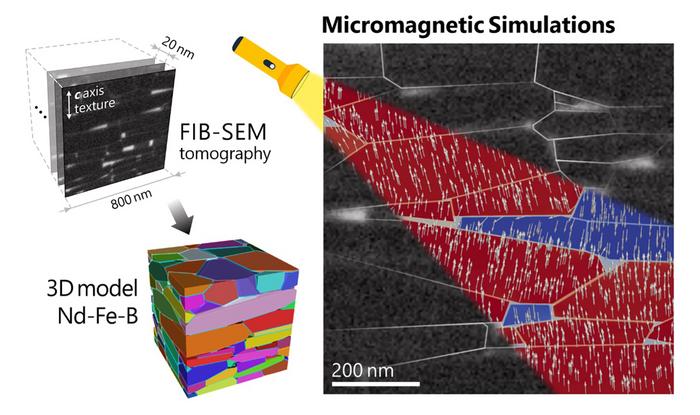1. NIMS has succeeded in simulating the magnetization reversal of Nd-Fe-B magnets using large-scale finite element models constructed based on tomographic data obtained by electron microscopy. Such simulations have shed light on microstructural features that hinder the coercivity, which quantifies a magnet’s resistance to demagnetization in opposing magnetic fields. New tomography-based models are expected to guide toward the development of sustainable permanent magnets with ultimate performance.

Credit: Tadakatsu Ohkubo
National Institute for Materials Science
1. NIMS has succeeded in simulating the magnetization reversal of Nd-Fe-B magnets using large-scale finite element models constructed based on tomographic data obtained by electron microscopy. Such simulations have shed light on microstructural features that hinder the coercivity, which quantifies a magnet’s resistance to demagnetization in opposing magnetic fields. New tomography-based models are expected to guide toward the development of sustainable permanent magnets with ultimate performance.
2. Green power generation, electric transportation, and other high-tech industries rely heavily on high-performance permanent magnets, among which the Nd-Fe-B magnets are the strongest and most in demand. The coercivity of industrial Nd-Fe-B magnets is far below its physical limit up to now. To resolve this issue, micromagnetic simulations on realistic models of the magnets can be employed.
3. A new approach to reconstruct the real microstructure of ultrafine-grained Nd-Fe-B magnets in large-scale models is proposed in this research. Specifically, the tomographic data from a series of 2D images obtained by scanning electron microscopy (SEM) in combination with consistent focused ion beam (FIB) polishing can be converted into a high-quality 3D finite element model (Figure). This tomography-based approach is universal and can be applied to other polycrystalline materials addressing a wide range of materials science problems.
4. Micromagnetic simulations on the tomography-based models reproduced the coercivity of ultrafine-grained Nd-Fe-B magnets and explained its mechanism. The microstructural features relevant to the coercivity and nucleation of magnetization reversal were revealed. Thus, the developed model can be considered as a digital twin of Nd-Fe-B magnets – a virtual representation of an object designed to reflect its physics accurately.
5. The proposed digital twins of the Nd-Fe-B magnets are precise enough in reproducing both the microstructure and magnetic properties that can be implemented for the inverse problem in designing on-demand high-performance permanent magnets. For instance, when researchers input the magnetic properties required for a specific application (e.g., traction or variable magnetic force motor), a data-driven research pipeline with integrated digital twins will be able to propose the optimal composition, processing conditions, and microstructure of the magnet for that application, significantly reducing development time.
***
6. This research was carried out by a team led by Anton Bolyachkin (ICYS Research Fellow at International Center for Young Scientists, NIMS), Hossein Sepehri-Amin (Group Leader, Green Magnetic Materials Group, Research Center for Magnetic and Spintronic Materials, NIMS / Associate Professor at Institute of Pure and Applied Sciences, University of Tsukuba), and Tadakatsu Ohkubo (Deputy Director, Research Center for Magnetic and Spintronic Materials, NIMS). The research was partially supported by the MEXT DxMT project (grant number: JPMXP1122715503) and the JSPS Grants-in-Aid for Scientific Research (grant number: JP23H01674).
7. The results of this research were published online in the journal npj Computational Materials on February 12, 2024 (DOI: 10.1038/s41524-024-01218-5).
Journal
npj Computational Materials
Method of Research
Experimental study
Subject of Research
Not applicable
Article Title
Tomography-based digital twin of Nd-Fe-B permanent magnets
Article Publication Date
12-Feb-2024



